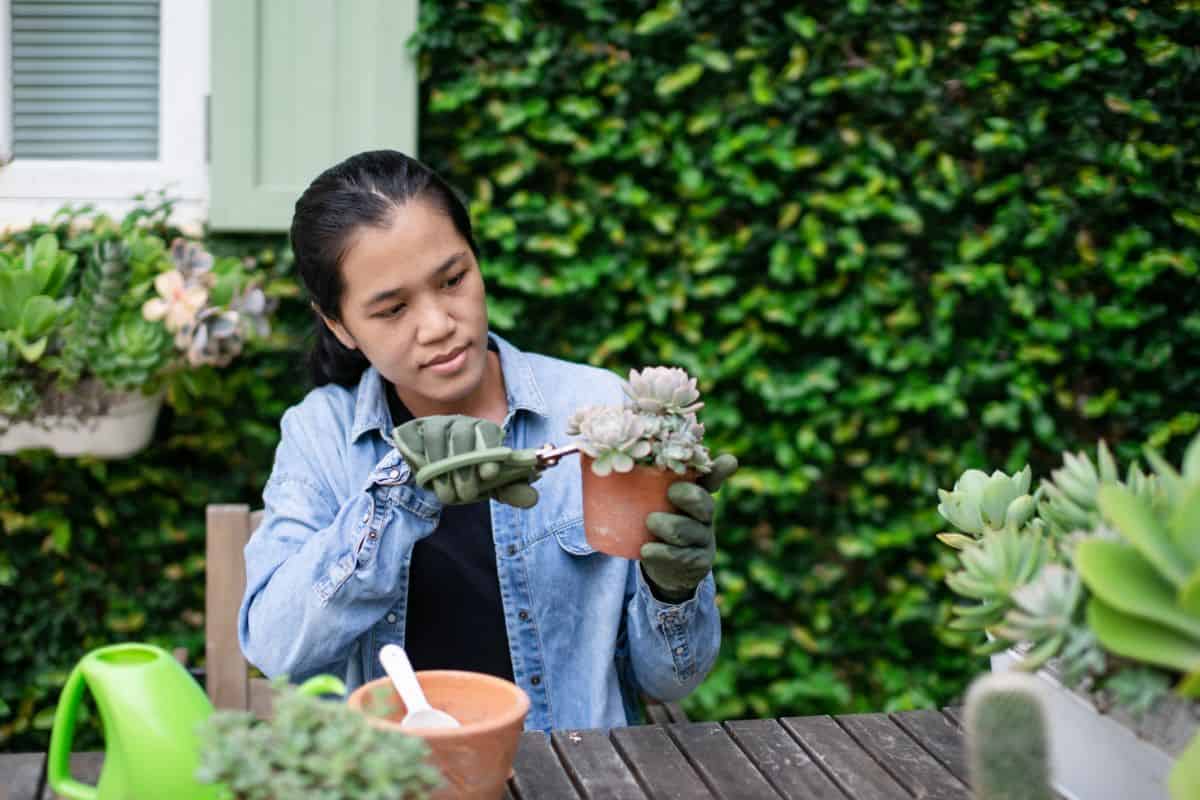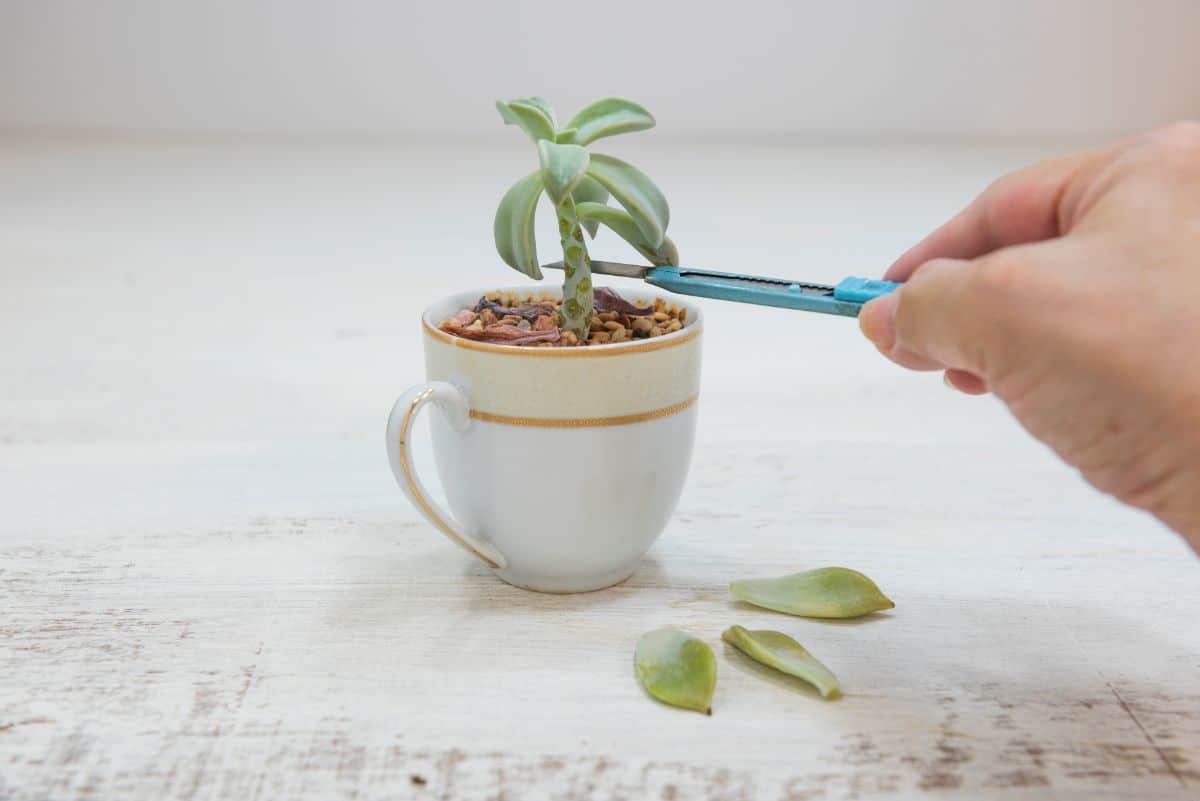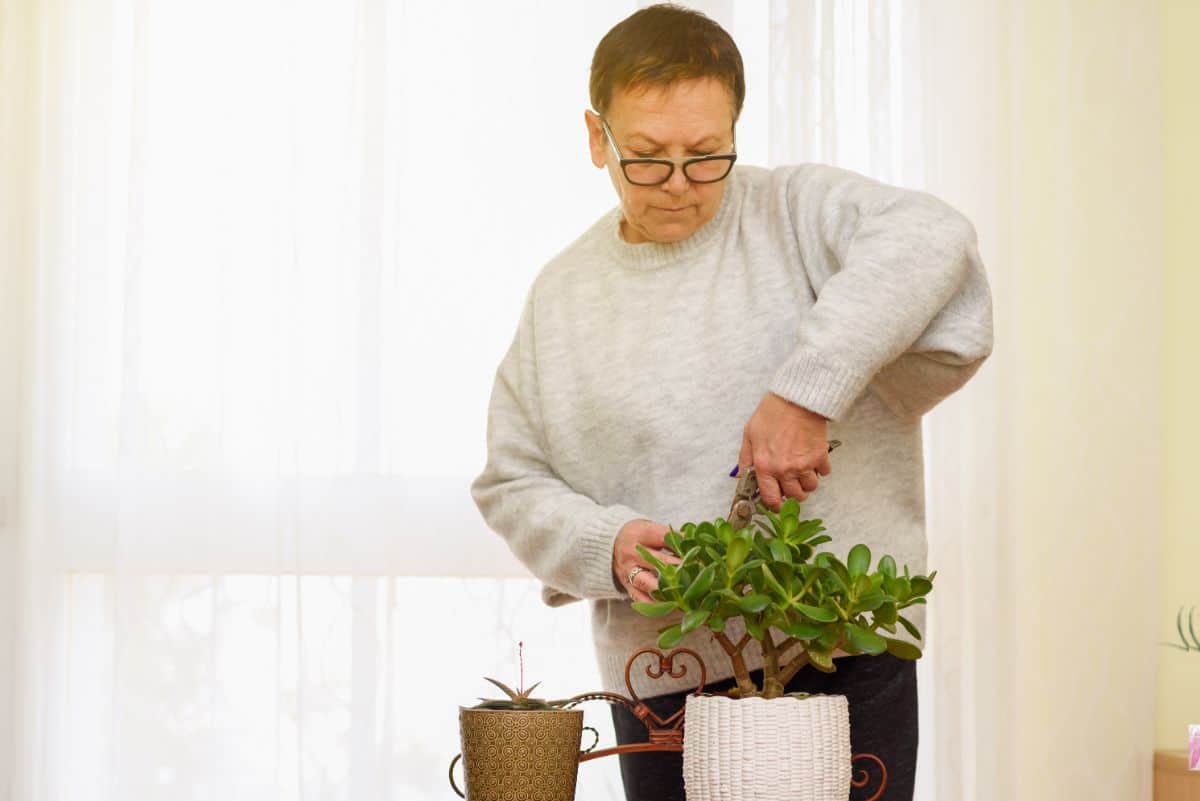
Learning how to trim a succulent can be intimidating at first, especially if you don’t know what to do. For gardeners, the idea of taking a sharp pair of scissors to your favorite plant is not easy. Still, it’s important to remember that pruning succulents is a fantastic way to help this type of plant grow.
Jump to:
Why Should I Trim My Succulents?
The easiest way to understand the benefits of succulent trimming is to imagine your plants as if they were hair. When your hair gets too long, giving it a trim allows the rest to grow more healthily by getting rid of split ends.
Learning how to prune succulents helps your plants grow more healthily. Succulent pruning allows you to eliminate any excess growth and dead leaves that consume too much energy. It is also a fantastic way to ensure your succulents maintain their original shape, adding to the aesthetics of your garden. There’s nothing more unappealing than overgrown plants that look unkempt with dead leaves.
It can seem scary at first, but you can easily learn how to prune succulents with the right tools and steps. Let’s get into the details of how you can begin taking care of your favorite plants.
How To Trim a Succulent
There’s no doubt that having a guide to maintaining your gardens is valuable. With succulent plants, pruning is relatively simple as long as you use the right items and do it at the right time. Let’s get into the easy-to-follow steps.
Step 1: When to Begin Pruning Succulents

When learning how to trim succulents, the first thing you’ll want to think about is when to start the process. Ideally, you will want to cut them at the beginning of their growing season. Choosing this time of year allows you to target overgrowth before it starts taking energy away from the rest of the plant.
Most succulent plants are bound to see new growth in the early spring, so you’ll want to focus your occasional pruning then. You will also find that trimming at the start of their season can help eliminate any extra winter growth. During the colder months, these plants tend to turn into leggy succulents as they crawl towards their light source.
Considering they will have plenty of access to direct light during the summer, these extra-long leaves aren’t necessary. This process is another great way to help the plant preserve its energy for optimal growth at the base.
Step 2: Get the Right Pruning Tools
No products found.
Succulent trimming is bound to be most successful if you have the right pruning tools at your disposal. There are two recommendations every succulent gardener should have: a pair of sharp scissors, a sharp knife, or pruning shears. Regular pruning shears can often be preferred, as they are designed for thick stems and don’t lose their sharpness quickly.
Also, pruning shears often come with extra benefits, such as spring-loaded mechanisms to help make clamping down on leaves simpler. Many have adjustable, ergonomic grips, which will help you manage multiple succulents with ease. You should be able to find the perfect pair of shears from your local garden center.
Another essential piece to consider having is a solid pair of gardening gloves. Gloves are necessary when handling specific succulent species, such as Prickly Pear Cactus. You’ll want to ensure you protect your hands from obtrusive spikes while managing your plants.
When pruning, you will want to prevent future infections, so it is essential to keep your shears or scissors disinfected. Thus, the last pruning tools you will need are a bottle of rubbing alcohol and some cotton pads or cotton balls.

Buy it from:
Step 3: Disinfect Your Tools
As mentioned, disinfection is the first step to take before getting to the pruning steps. You will want to douse a cotton ball or pad with rubbing alcohol and gently rub the blades of your cutting shears. Doing this can help get rid of any extra dirt and grime to protect your plants.
Also, did you know that succulents are particularly prone to pests, such as mealybugs? If one of your plants has a mealybug infestation, it is easy to spread the pests from one plant to another. That's why you must also disinfect your tools with an alcohol wipe when you move onto a new plant while pruning.
Step 4: Plan Your Cuts
It can be tempting to get right into trimming succulents, but you will first want to map out what needs to be pruned. Otherwise, you could be stuck cutting too much off your succulent arrangements, taking away from their beauty. A better alternative is to check which succulent stems have too much growth and start there, working slowly.
Remember to leave enough growth so that the plant doesn’t look lopsided or fall over once finished. Also, make sure you cut areas where you can easily adjust your shears, as your cuts should be straight or slightly angled.
Step 5: Begin Trimming Succulents

Now that you are prepared to learn how to cut succulents, let’s get into the fun part: trimming! With your plan in mind, begin cutting away at the overgrown succulents to make a huge difference. With each cut, you will want to place your shears one to two inches below the top growth ends.
It is important to leave a little bit of stem behind, especially if you are putting it into a new pot. Otherwise, the plant could fall over or stick out of the soil too much. Also, be sure to cut the fleshy leaves at a slight angle or as straight as possible for a clean cut.
As you work through your plants, be sure to keep the succulent cuttings aside, as we can use them in the next steps of the process. There is nothing better than making use of the extra growth your garden plants have experienced over the winter.
Step 6: Allow Time to Dry
After you’ve finished cutting the plants, be sure to let the plant dry out for a few days. This process will allow the roots to get rid of any extra moisture before being watered again. Once a couple of days have passed, you can return to your standard watering schedule.
Step 7: Use the Succulent Trimmings
When learning how to trim succulents, it’s a good idea to know what to do with the plant cuttings afterward. Interestingly, succulents are fantastic to propagate, allowing you to grow a baby plant from the mother plant.
With your trimmings in hand, gently place each one on a paper towel to dry for two to three days. Once the tips feel slightly dry, put them into fast-draining soil. You can then use a spray bottle to gently mist the succulent soil with plain water, ensuring it feels damp to the touch.
Maintain moistness around the soil for several days, which should encourage healthy root growth. You will begin to notice some root development within a few weeks and can resume the watering schedule on a regular basis.
Over time, you will grow an entire plant that can continually be propagated. As you can imagine, this process is a fabulous way to increase the fleshy plants in your garden.
Trimming a Succulent
Learning how to trim a succulent is a fantastic way to keep your plants in their best condition. Also, knowing how to cut succulents can help you propagate extra plants for your garden or grow some to give away to family and friends. With the right tools and techniques, you can become a master gardener in no time.

